
Head Surgery Page Menu: 1 2 3 4 5 6 7 8 9 10 11 12 13 14 Next>>
Head Surgery During the Golden Age of Piracy, Page 9
Trepanning Operation
During the golden age of piracy there were basically two reasons to drill a hole in the skull. The first was to relieve pressure on the brain by giving blood trapped beneath the skull egress. The second was to allow tools easier access to the dura mater when trying to remove stubborn foreign objects or get under a depressed part of the fractured skull so that it could be pried up. Richard Wiseman explained that when the skull was fractured in an accident but it was not large enough to prevent fluid from building up under the skull, "then the Trepan ought to be applied, to give vent to the Serum, and to make way for the raising the deprest Bone."1
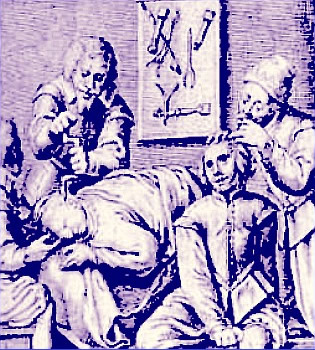
Trepanning the Skull, Ambroise Paré, The Workes of that
Famous
Chirurgion Ambrose Parey, frontispiece (1649)
Several sea-based case studies back this up. By way of an example of relieving pressure on the brain, sea surgeon John Moyle explained in a case that "when the round piece of Bone was taken out, there gushed out abundance of putrid and filthy Sanies [serum, blood and/or pus, discharged by wounds]: by which discharge of Matter the Man found Ease."2
Sea surgeon John Atkins provided a case where the skull was trepanned to allow him to remove a wood splinter in the parietal bone.
We dilated [cut open[ the Wound, in order to extract this Splinter with a Forceps, or other Instrument; but finding our Endeavours in vain, and not being able to judge at what Depth it stuck, or the Accident that it might ensue from leaving it in any Time, we thought proper next Day to apply the Trepan, and found an odd Circumstance after the Operation; for the first Table [of the skull] being removed, the inner [table] appeared depressed to a pretty large Circumference.
The Operation was repeated through both Laminæ [tables of the skull], and the deepest Part of the Depression, till the Splinter was brought away.3
Let's look at the details of how this critical operation was performed at this time.
1 Richard Wiseman, Of Wounds, Severall Chirurgicall Treatises, 1676, p. 380; 2 John Moyle, Memoirs: Of many Extraordinary Cures, 1708, p. 20; 3 John Atkins, The Navy Surgeon, 1742, p. 89-90
Trepanning Operation - Speed
Most of the surgeons during the golden age of piracy agreed that performing the operation quickly was important to its success. John Atkins explains that when the skull is to be trepanned, it should be done "Quickly also, because
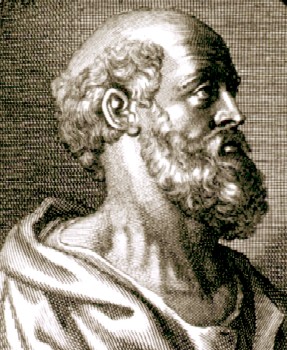
Hippocrates
procrastinating is dangerous"1.
John Moyle is even more strident on this point. "Then if the bleeding will permit you to see the Fissure [in the skull] plainly, make no delay, but apply your Traphine at once... For if the Fracture be through the second Table [of the skull], and that there is a concussion, then the Traphination [trepanning] cannot be evaded, but must be performed first or last, and the sooner the better, for the extravasated [leaking] blood must have vent out, or the Mans life cannot be saved."2
Interestingly, Hippocrates, who was revered in the medical profession at the time, counseled differently. "With regard to trepanning, when there is a necessity for it, the following particulars should be known. If you have had the management of the case from the first, you must not at once saw the bone down to the meninx [meninges – the dura mater]; for it is not proper that the membrane should be laid bare and exposed to injuries for a length of time, as in the end it may become fungous [fungus-like]."3
However the work of a sea surgeon was that of triage, especially during battle. Speed in addressing the most critical wounds was of the essence. Even so, Hippocrates' concerns about leaving the brain exposed were discussed, perhaps suggesting an evolution in how rapidly such wounds were dressed.
1 John Atkins, The Navy Surgeon, 1742, p. 85; 2 John Moyle, Memoirs: Of many Extraordinary Cures, 1708, p. 108; 3 Hippocrates, On Injuries of the Head, Translated and Edited by Francis Adams, 1849, p. 465
Trepanning Operation - Warmth
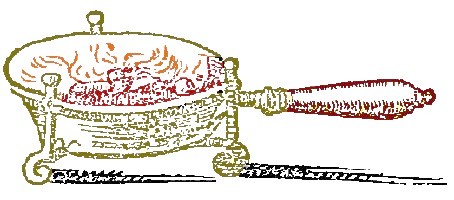
Chafing Dish, From A course of chirurgical
operations, By
Pierre Dionis, (1708)
Reflecting the concern about exposure of the brain was a dictum by surgeons to perform the operation in a warm place.
Military surgeon Richard Wiseman simply says "The Room [where the trepanning is performed] ought also to be close [warm]."1 It was previously noted that John Woodall recommended that "the Patient [to be] placed close and warme from the ayre"2. Sea surgeon John Atkins likewise recommends that the operation be performed "In a close [warm] Place, and by Candle-light, Air, according to the Aphorism [referring here to Hippocrates], being an Enemy to the Brain and Bone"3. Although he doesn't go into detail about his reason, Pierre Dionis specifies a chafing dish of coals like that shown above be included among his instruments for trepanning.4 Keeping the patient warm during the operation was widely supported at this time.
1 Richard Wiseman, Of Wounds, Severall Chirurgicall Treatises, 1676, p. 381; 2 John Woodall, the surgions mate, 1617, p. 5; 3 John Atkins, The Navy Surgeon, 1742, p. 85; 4 Pierre Dionis, A course of chirurgical operations: demonstrated in the royal garden at Paris. 2nd ed., p. 282
Trepanning Operation - Trepan Blade Type and Size
There were a variety of different trepanning blades available to a surgeon. A full discussion of the five different types can be found in the article on Head Surgery Tools.

Piercer Blade in Brace Trepan, Pierre Dionis, A course of chirurgical
operations (1708)
We will focus here on those that might be of interest to sea surgeons during the golden age of piracy: the piercer and taper blades.
The piercer could be used to make the initial 'pilot' hole in the skull that would guide the sharp pin found in the center of the tapered trepan blade which bored the hole in the skull. Beyond that, it seems to have had little use here.
The tapered hole-cutting blade was much more important since it actually cut the hole in the skull. This blade was designed so that the taper of the blade actually slowed the cutting process down. (This is because it drilled both down and out at the same time, cutting the hole in the bone wider as it cut deeper.) The purpose of this design was to prevent the surgeon from piercing the brain as easily as he might using the straight-sided crown blade.1
Most of the 
Tapered Blade Sizes, A course of chirurgical
operations, Pierre Dionis, (1708)
surgeons don't say much about blade design, although both sea surgeon John Atkins and French surgical instructor Pierre Dionis mention the use of a tapered blade and its ability to help prevent the toothed crown of the blade from damaging the dura mater.2
The surgeon usually had a few different sized tapered blades available to him. Few of the surgeons from this time give advice on which size was preferable, leaving this decision to the surgeon based on his experience and the type, location and appearance of the wound. The usually thorough Dionis advises his students:
The Chirurgeon must begin with the Choice of the Crown which he intends to use; wherefore I shew you three of different Sizes, the larger F, the middle one G, and the little one H, and being determin’d by the Nature and Figure of the Wound it self, he pitches on that which is most convenient3.
Much of a sea surgeons' training occurred through experience and/or apprenticeship. As a result, his recognition of the type of wound would have provided a better guide to choosing a blade than any text-book based information.
1 John Woodall, the surgions mate, 1639, p. 314; 2 See John Atkins, The Navy Surgeon, 1742, p. 86-7 & Pierre Dionis, A course of chirurgical operations: demonstrated in the royal garden at Paris. 2nd ed., p. 285; 3 Dionis, p. 283
Trepanning Operation - Oiling the Blade
Two surgeons from this period recommend lubricating the trepan's teeth just before the operation begins. Richard Wiseman orders the surgeon to "use a little ol. ros. [oil of roses] or Milk to cause it to move the easier"1. Sea surgeon John Atkins suggests a similar step, "smearing the Crown of the Trepan with Oil, for its easier Motion"2. This would also have helped keep the blade cool.
1 Richard Wiseman, Of Wounds, Severall Chirurgicall Treatises, 1676, p. 381; 2 John Atkins, The Navy Surgeon, 1742, p. 86
Trepanning Operation - Drilling a Pilot Hole
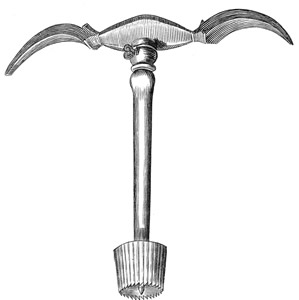
Trefine, the surgions mate, John Woodall (1639)
The trepan blade had ridges on the outside of the tapered blade which continuously cut the bone and widened the hole as it was turned and pushed down. The inside of the blade was hollow so that the toothed bottom edge of the blade was as thin as possible to minimize any damage the teeth might cause if they accidentally touched the dura mater. In the center of the pyramid-shaped blade was a sharp removable pin that jutted just below the teeth on the bottom to allow the blade to remaine centered. To guide this pin a pilot hole might be created in the skull. (More will be said about the pin in the next section.)
Pierre Dionis provides a process for creating the hole with the piercer blade. He begins by explaining that the surgeon "presents it [the trepan] to the Place to which he is resolv’d to apply it ...then turns the Crown once or twice round, to mark the Circumference which is to bound the Trepan, and to discover the Middle."1 The purpose of that was to see where the blade was going to cut through the bone, making it possible to reposition the blade if the surgeon felt the location was unsuitable for any reason.

Piercer Blade in Brace Trepan, Pierre Dionis, A course of chirurgical operations (1708)
"He next takes the Gimlet [brace handle] I, on which he mounts the Piercer K, which he fixes on the Place traced out by the point of the Pyramid which was in the Crown, and turning it five or six Rounds, he makes a small Orifice the depth of a half Line, or the four and twentieth Part (1/24) of an inch, which serves to lodge the Point of his Pyramid, and so to conduct the Crown, that it shall not Waver either on one side or the other."2
You may wonder why Dionis didn't just rely on the sharp pin in the center of the tapered blade to create the the hole for itself. You are not alone; that's what the eminently practical sea surgeon John Moyle suggests. "First agitate the trefine gently until you through the first Table"3. However, a notable difference between Dionis and Moyle's explanation is that Dionis is using a brace-handled trepan and Moyle is using a T-handled trefine. The trefine was typically several inches shorter than the trepan which might make aligning the blade by sight a little easier for the surgeon.
1 Pierre Dionis, A course of chirurgical operations: demonstrated in the royal garden at Paris. 2nd ed., p. 283; 2 Dionis, p. 283-4; 3 John Moyle, The Sea Chirurgeon, 1693, p. 110
Trepanning Operation - The Use of the Pin
As mentioned, the purpose of the pin in the center of the
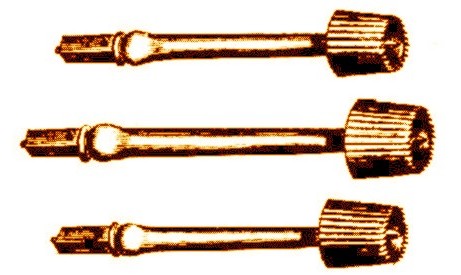
Tapered Blades, From the surgions mate, by John Woodall (1639)
trepan's blade was to keep the blade centered while the its ridged sides were doing the hard work of cutting through the skull. Regarding its construction, John Woodall explained that the pin needed to be "placed truly in the center... [and] made of good steele, and that it be triangular, also that it be sharp each way [on each of the three sides], well pointed, and stand fast in the Instrument"1.
Woodall specifies another interesting aspect of the pin in his book. He says it should "stand no lower, but always somewhat higher than the circumferent teeth of the head of that Instrument does, for because the said pinne in the center guideth the circumferent tooth-head-saw, to the beginning of the worke"2. His wording is confusing, making it sound as if the pin is recessed - tucked inside the saw blade. The angle of his images of the blade (seen above) are not completely helpful in clarifying this. However, Woodall later says "the said pinne in the center guideth the circumferent tooth-head-saw, to the beginning of the worke, and in the agitating and mooving of the Trafine with the hand to and fro in this worke, the said pinne may first take hold, ere [before] the teeth of the Instrument touch the scull"3 and still later that "the said pinne [is] longer then the teeth of the Instrument"4.

Tapered Blade, From The French Chirurgerie, By
Jacques
Guillemeau (1598)
Fortunately, Woodall's was not the only image of the tapered crown design. Jacques Guillemeau's book (which predates Woodall) shows a tapered blade with the pin extending well past the teeth on the edge of the crown. This is why Moyle was able to use the tapered blade to start the operation without first drilling a pilot hole as discussed in the previous section.
Woodall uses the pin for another purpose as well. In the 1617 edition of his
book, he directs the surgeon to "set the Trapan thereon [the sound part of the fractured skull], namely the pin thereof is always to be set on the whole part of the Craniu[m], wherby the most part of the Trapan by consequent standeth
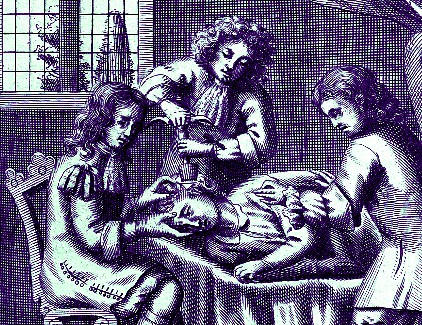
Surgeon Trepanning a Patient Held by Two Assistants, From A compleat discourse of
Wounds by John Brown - From the Wellcome Collection (1678)
on the whole bone, but so that almost halfe may stand on the fractured part of the bone."5 So Woodall is using the pin as a locator to make sure that more than half of the blade will be cutting the sound part of the skull. (As long as the pin is sitting on the sound part of the fractured skull, more than half the round blade must be situated on the skull if the pin is in the true center of the blade.) This would put the majority of the downward pressure on solid bone and keep the blade from mashing the more flexible, damage-weakened bone against the brain when cutting.
The pin was only useful until the teeth on the edge of the trepan blade had cut into the skull. After that, it was a danger to the patient. Fortunately it was designed to be removed from the tool, being threaded at the bottom. The surgeon had a small, key-like tool that fit over the sharp edges and allowed the surgeon to unscrew it.
Woodall says that once the outer edge of the saw had created a furrow in the skull "then the sooner the better the Artist is to take up the Instrument, to wipe and cleanse the teeth thereof, and draw out the said pinne in the center, the which he may nowayes omit"6. Sea surgeon John Moyle explains in one of his case studies that once a "Foration [perforation] was made through the first Table [of the skull], (or at least till it had taken good hold;) then [the blade] being withdrawn, it [the pin] was taken out, and (the Work cleansed) it was applied again without the Pin"7.
Military surgeon Richard Wiseman provides a little more detail in his explanation of how to determine when to remove the pin. "Before you approach the second Table [of the skull], (which you may know by the bloud that appears,) it will be required that you take out the Pin, and proceed more warily, not listening to the pratling of the Standers by"8.
As usual, French surgical instructor Pierre Dionis give the most detail on how to operate the tool. The surgeon must begin
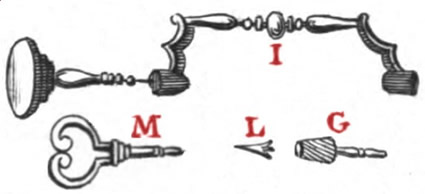
Brace Trepan Pin Removal Tools. (Note that pin L seems to be out of proportion.)
From A course of chirurgical operations, By Pierre Dionis (1708)
with his Left-hand holding the Top or Ball of the Gimlet [brace handle I], on which he leans his Fore-head, he turns the instrument with his Right-Hand, against the Grain of the Teeth of the Saw [G], that they may cut. He turns it at first gently, till the Crown has a little penetrated the Bone, in order to mend its Pace at the Beginning, in which there is no Danger. We cannot prescribe how hard the Operator is to lean his Head, he is to determine that for himself; for if he leans too hard, he will scarce be able to turn the Instrument; and if he does not press it enough, he will not penetrate: He must turn it equally, and not by fits and shocks, and when he believes he has proceeded about the twelfth part of an Inch, he raises the Crown, and takes away the Pyramid L, with the Instrument M, because it then becomes useless, the perforation [made by the teeth on the circumference of the blade] being sufficient to guide the Instrument without the Pyramid, which may also happen, (not without great Danger)to prick the Dura-Mater, if we forget to take it out.9
Several surgeons suggest that it be taken out when the teeth of the round blade have cut a slight furrow in the skull. Others suggest watching for a bit of blood on the teeth of the blade, which indicates that it has cut into the diploë of the cranium - the spongy, porous, bony tissue between the hard outer and inner bone layers of the cranium. Both methods would involve removing the tool from the skull to monitor progress.
1,2,3 John Woodall, the surgions mate, 1639, p. 315; 4 Woodall, 1639, p. 316; 5 John Woodall, the surgions mate, 1617, p. 5; 6 Woodall, 1639, p. 315; 7 John Moyle, Memoirs: Of many Extraordinary Cures, 1708, p. 13; 8 Richard Wiseman, Of Wounds, Severall Chirurgicall Treatises, 1676, p. 381; 9 Pierre Dionis, A course of chirurgical operations: demonstrated in the royal garden at Paris. 2nd ed., p. 284

